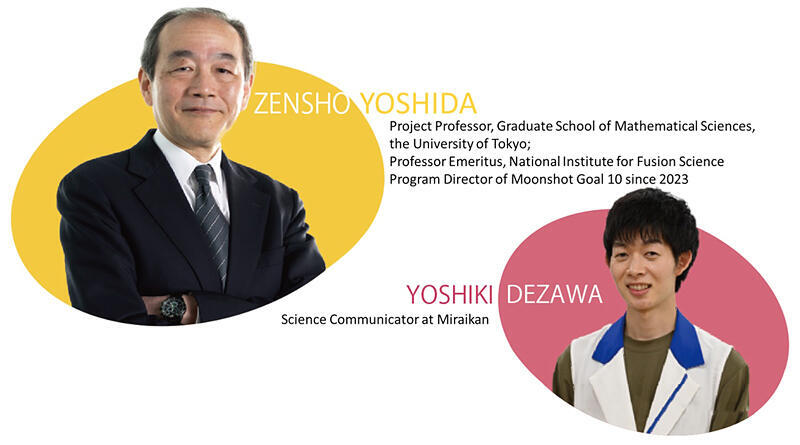The Moonshot Research and Development Program, which began in 2020, aims to create disruptive innovations from Japan. This article introduces Goal 10, newly established in 2023: "Realization of a dynamic society in harmony with the global environment and free from resource constraints, through diverse applications of fusion energy, by 2050." The goal is to implement fusion energy in society, which researchers worldwide have been pursuing for over 70 years. Yoshiki Dezawa, a science communicator at the National Museum of Emerging Science and Innovation (Miraikan), interviewed Program Director Zensho Yoshida, Project Professor at the Graduate School of Mathematical Sciences, the University of Tokyo (Professor Emeritus at the National Institute for Fusion Science).

Abundant deuterium in seawater as fuel - Contributing to conflict reduction and space exploration
Dezawa: "Fusion energy" is not a familiar term for many people. Could you explain what it is?
Yoshida: This term has been used by the government since 2023, aligning with Western terminology. You might be more familiar with the term "nuclear fusion energy." Nuclear fusion is a reaction where light atomic nuclei, such as hydrogen isotopes, merge to form heavier nuclei, releasing enormous amounts of energy in the process. The sun also burns through this nuclear fusion reaction.
Dezawa: What are the characteristics of nuclear fusion?
Yoshida: One is the stability of fuel supply. Deuterium, the fuel for nuclear fusion, is a light element abundantly found in seawater, with virtually no risk of depletion or supply issues due to regional concentration. Another is the self-sufficiency of energy supply. Nuclear fusion can complete the entire process—from fuel extraction to power generation and supply—within a single system, making it less susceptible to external factors such as fuel transportation disruptions or supply chain issues.
Dezawa: How will society change when fusion energy becomes practical?
Yoshida: Current major energy resources like fossil fuels are concentrated in specific regions, sometimes causing international conflicts over their acquisition. However, fusion energy can be fueled from seawater, reducing resource concentration and potentially decreasing causes for conflict. Furthermore, stable energy supply will drive the development of new industries and technologies. Fusion energy will be particularly powerful in fields where conventional energy sources struggle to provide adequate supply, such as space exploration, deep-sea exploration, and the development of digital spaces.
Beyond power generation — Miniaturization of large-scale equipment as a challenge
Dezawa: What kind of society is Goal 10 aiming for by 2050?
Yoshida: This project aims to accelerate the research and development of fusion reactors while exploring multifaceted applications of fusion. Traditionally, our main goal has been power generation, but now we are also considering "off-grid" uses where electricity is self-sufficient without connection to power company transmission networks, as well as hydrogen production and other new energy supply systems. We are also exploring applications beyond the energy sector, such as using particles generated from fusion reactions for medical purposes and radioactive waste treatment.
Dezawa: What challenges are you facing in advancing this plan?
Yoshida: One of the challenges for practical fusion implementation is reducing the size of the equipment. Currently, it is almost certain that we can produce more energy than we input by creating nuclear fusion reactions in high-temperature plasma. However, this assumes the reactor is sufficiently large. For economic viability, miniaturization is necessary, but smaller reactors mean the plasma cools down more easily, making it difficult to maintain high temperatures.
Dezawa: I see. So, you'll be taking on the challenge of determining how much miniaturization is possible.
Yoshida: Large-scale experimental reactors like the International Thermonuclear Experimental Reactor (ITER) require over ten years to build and trillions of yen in costs, so the development of prototypes must proceed cautiously. Project Manager Takeo Hoshi from the National Institute for Fusion Science is running a project aimed at building a "digital laboratory" that uses simulation and AI technology to design and test performance in a digital space.
Dezawa: So, you're saying that simulations will be used to conduct as much verification as possible in advance?
Yoshida: That's right. Additionally, Project Manager Takanobu Kiss from Kyushu University is working on the miniaturization and performance enhancement of high-field superconducting magnets, a key technology for the miniaturization and economic viability of fusion reactors. Also, since fusion reactor operation requires materials that can withstand extremely harsh environments such as high-energy neutron irradiation, Project Manager Hiroki Okuno from RIKEN is advancing the development of long-life, high-durability material development and testing systems through disruptive innovations in accelerator technology.
Technology that should be shared globally — Interdisciplinary approach as the key
Dezawa: How do you personally envision the development of fusion technology by 2050?
Yoshida: Goal 10 has a planned research and development period until the mid-2030s, but I believe it's important that the technologies and knowledge gained are passed on to industry. It's not just researchers—industry also needs to continuously conduct development toward practical application. I expect a society where the outcomes of this project become "tools" utilized by industry, realizing diverse applications of fusion energy.
Dezawa: Fusion reactor development is accelerating not only in Japan but worldwide. What role should Japan play in this context?
Yoshida: Japan is internationally highly regarded in fusion research. Fusion technology is not something to be monopolized by a single country but should be shared globally. Therefore, Japan is expected to take leadership in international cooperation, building relationships of trust with other countries while implementing the technology.
Dezawa: Finally, what aspects of fusion research do you find most appealing?
Yoshida: Fusion involves very complex physical phenomena with many unresolved aspects. Therefore, participation from researchers in different fields is essential, and an interdisciplinary approach is key to breakthroughs. That's why we've invited Project Managers and advisory board members from a wide range of fields including various branches of physics, materials science, and data science. The appeal of this research lies in the opportunity to set your own challenges and collaborate with people from diverse fields to explore unknown territories.





